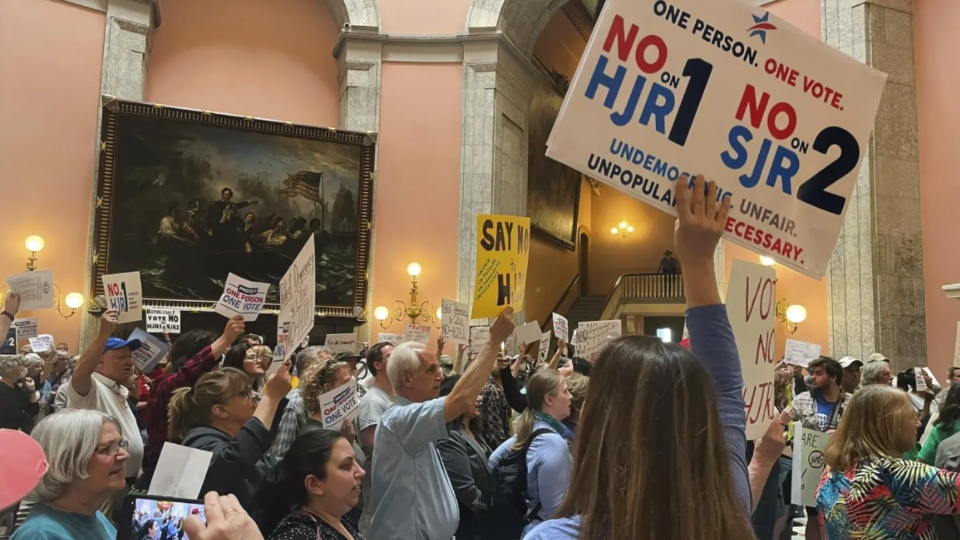
COLUMBUS, Ohio—The people of Ohio are in a fight for the soul of democracy in the heart of the U.S.—a struggle that will culminate with a statewide special election on Aug. 8. On the ballot that day is only one thing: majority rule.
Issue No. 1, if passed, will restrict Ohioans’ right to democratically decide future ballot measures by requiring an unattainable 60% approval on constitutional amendments and doubling the already tough signature collection criteria. Ohio Republicans, with their highly effective party apparatus and a good deal of help from outside capital, are seeking to eliminate one of the last vestiges of the progressive movement that started in the early 1900s.
Despite the GOP’s political and financial juggernaut, progressive movements invigorated by the overturning of Roe v. Wade have gathered enough momentum to cement the right to make reproductive choices into the state constitution.
Fearing this resurgent movement and its potential to bypass the Republican monopoly on power in the legislature, an ultraconservative reactionary contingent of politicians is leading the charge to strangle the right to citizen referenda with Issue No. 1.
The Ohio Senate, on April 19, voted along party lines (26-7) to send the amendment to demolish direct democracy to the ballot. Secretary of State Frank LaRose gave a deadline of May 10 for any legislatively referred ballot questions, and the Ohio House of Representatives squeezed through with a 62-37 on the deadline day. Only five Republicans broke ranks to oppose the measure, along with every Democrat. The double death blow sent the measure on its way toward the August ballot.
Ohio has had two constitutions in its history, one from when it first applied for U.S. statehood in 1803, and another half a century later in 1851. The 1851 constitution offered tokens of power to the general voting base, which at that point was still solely a constituency of adult white men, specifically small businessmen and private farmers, for the most part.
One of these tokens, a mandatory referendum every 20 years for a constitutional convention, was taken up and made useful by the Progressive movement in 1912. The Progressives, which were heavily influenced by socialists and labor nationwide and in Ohio, forced the hand of the Ohio state government to adopt strong worker protections and to devolve some direct powers to the people.
The most powerful tool that the 1912 Ohio constitutional convention put in the hands of the people was the power to propose and vote on citizen-led constitutional amendments.
In the aftermath of this democratic victory, persistent efforts by business interests and social conservatives have eroded this public power to make change. Since 1912, there has only been one citizen-led ballot issue regarding the powers of direct democracy that successfully passed, and that was in 1918. Every other amendment on the topic has been led by the legislature and ended up restricting the people’s powers.
In 1971, the Ohio General Assembly proposed and campaigned for a change that eliminated mailed notices for new amendment proposals, replacing these with newspaper notices in an effort to lower voter awareness and turnout.
A few years later, in 1974, the General Assembly again convinced voters to back an amendment that restricted challenges to the language of ballot measures that were legislatively referred, and again eased the process for the legislature to change the constitution by developing its own ballot initiatives.
A 1978 amendment created the Ohio Ballot Board, an attempt to give legislatively proposed amendments an air of objectivity by preventing the direct drafting of amendment proposals by lobbyists. Also included were requirements that petitions for citizen initiatives be as restrictive as candidate petitions, and lowering the number of requirements for advertisements of referendums. The result, again, was to pare back public awareness about ballot questions.
Starting in 2008, a new push for restrictions on the ability of the people to directly effect change was initiated. Ballot Issue No. 1 required that ballot questions be forced to the very next election, gave the Board of Elections authority to determine the validity of citizen-led petitions, and placed citizen-led petitions under the purview of the Ohio Supreme Court with rapid deadlines.
These requirements restrict the ability of citizen-led initiatives to mount a defense from any challenges made by state bodies, which were already beginning to be dominated by the Ohio GOP. Since the adoption of Ballot Issue No. 1, only three out of 80 proposed citizen-led initiatives have been passed.
Ohio, which has been coined a bellwether of U.S. politics, is a battleground in the fight to defend democracy. The question of whether democratic governance—even as limited as it might be—or reactionary authoritarianism will win out is being waged in courtrooms, in the legislature and, on Aug. 8, at the ballot box.
We hope you appreciated this article. At People’s World, we believe news and information should be free and accessible to all, but we need your help. Our journalism is free of corporate influence and paywalls because we are totally reader-supported. Only you, our readers and supporters, make this possible. If you enjoy reading People’s World and the stories we bring you, please support our work by donating or becoming a monthly sustainer today. Thank you!










